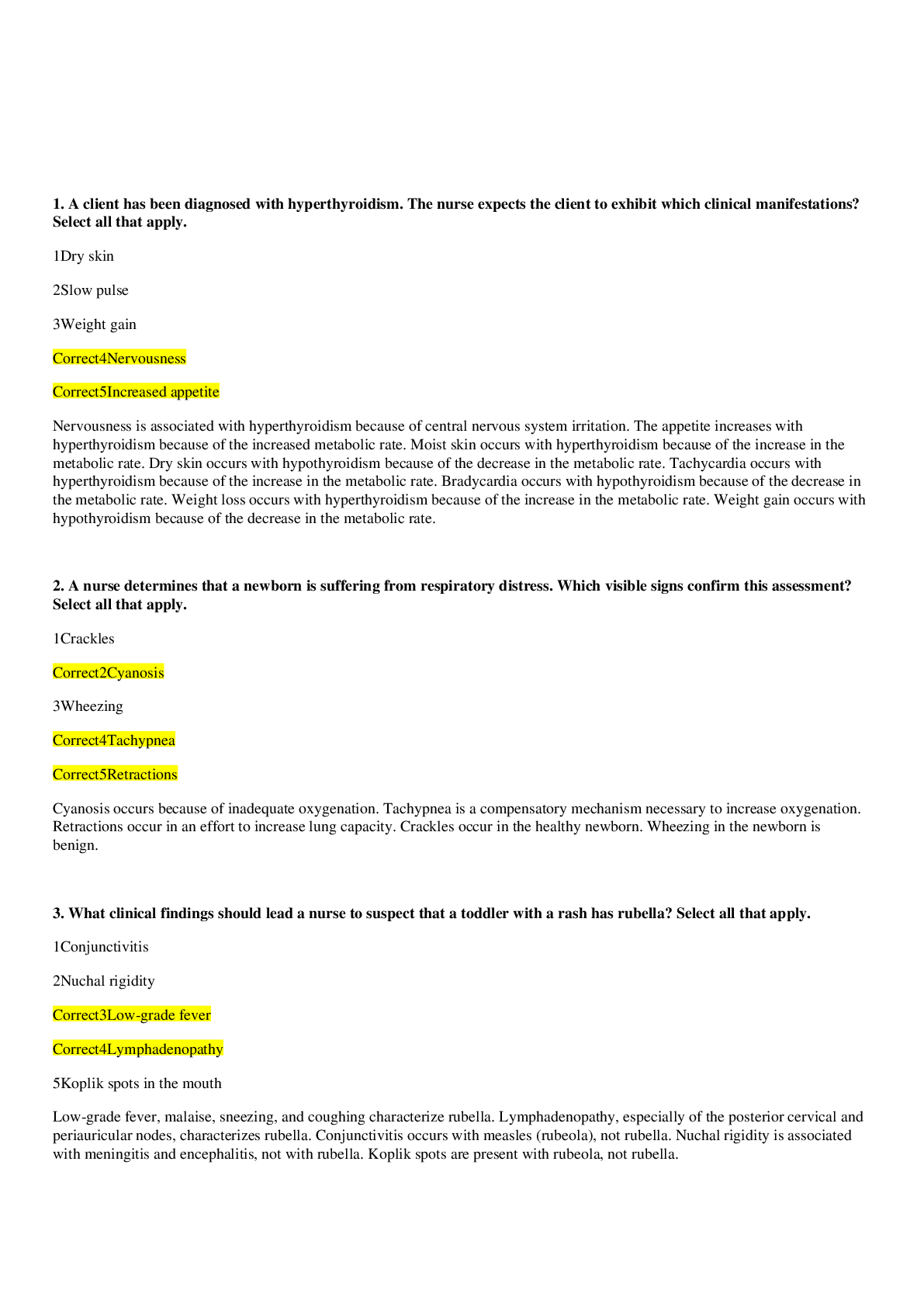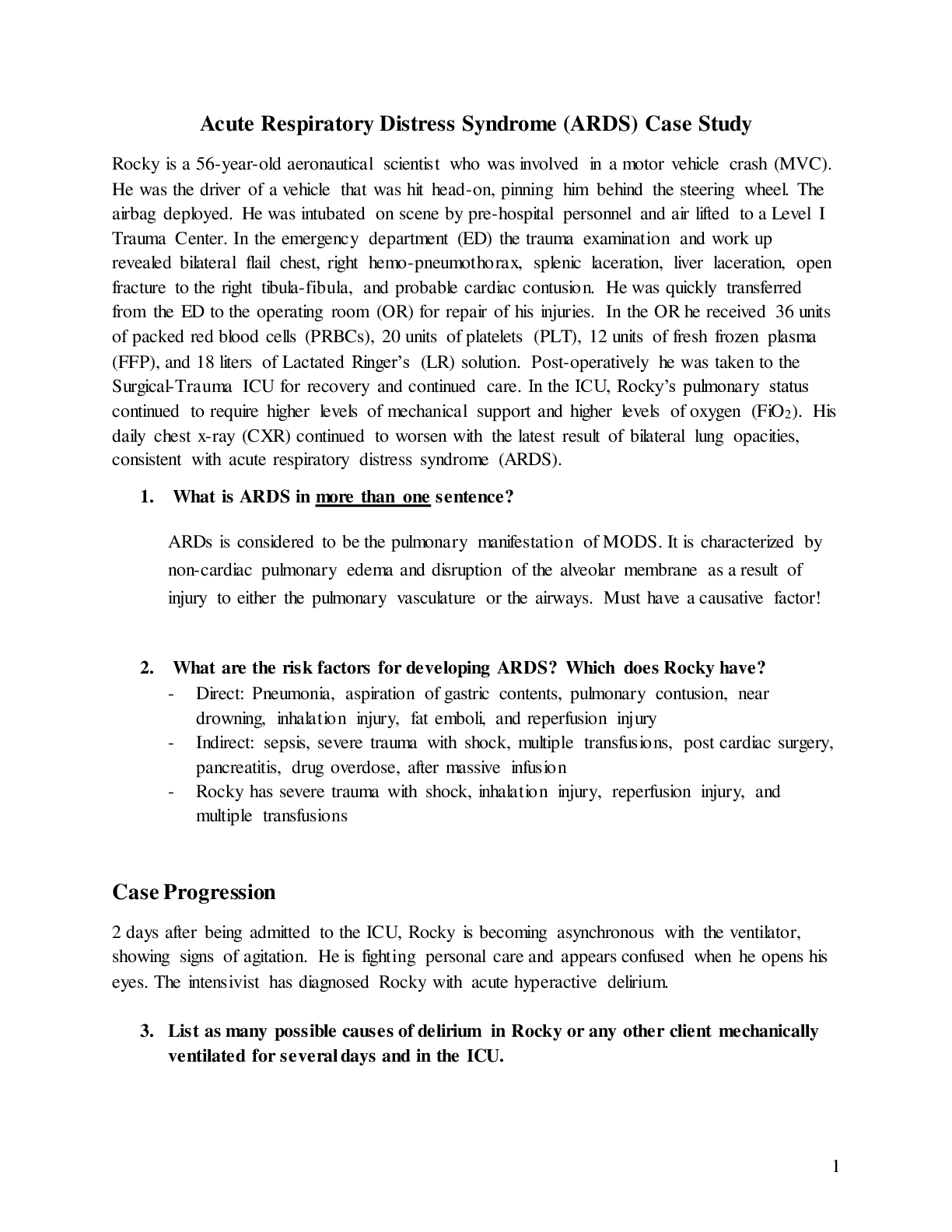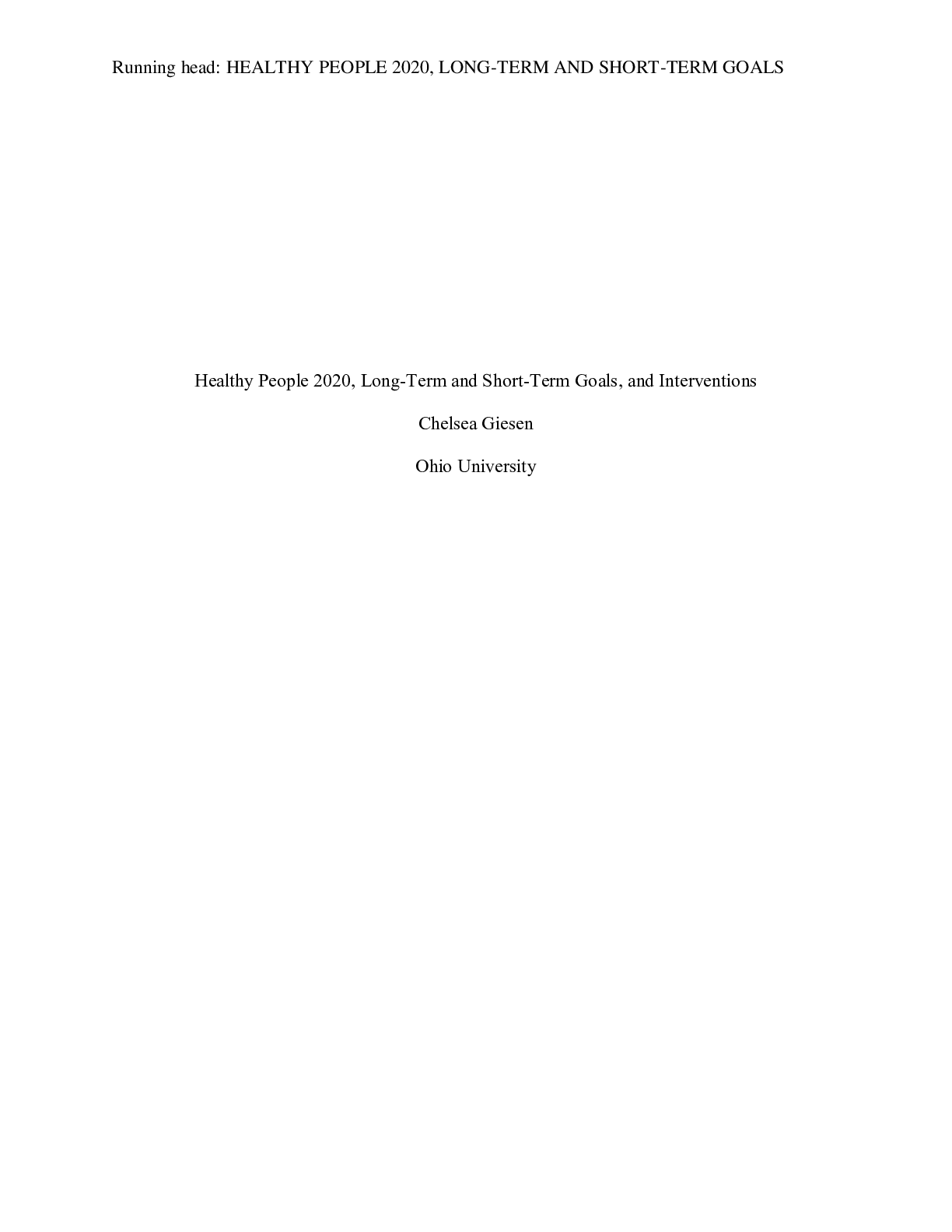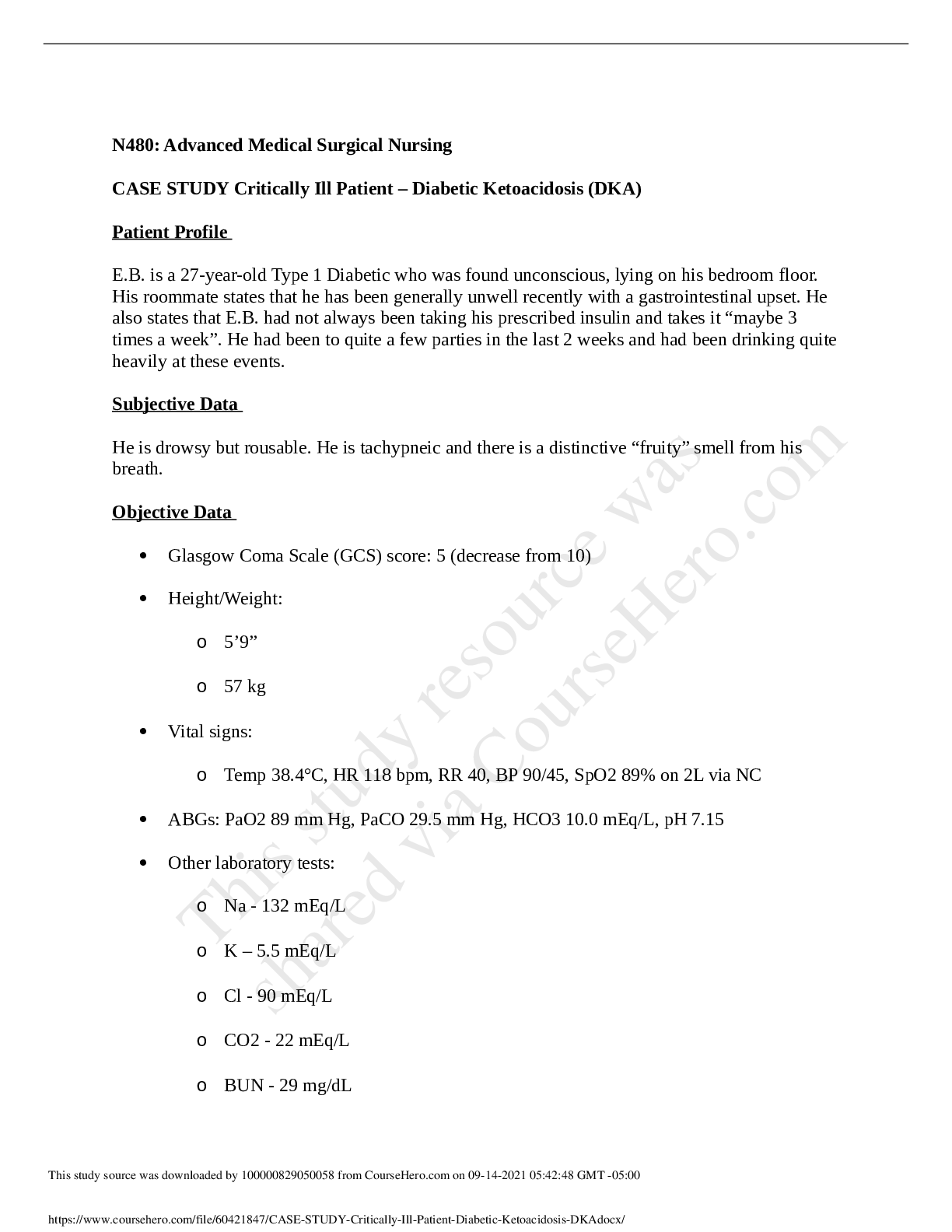*NURSING > CASE STUDY > Concept 1 Adaptive Quizzing Physiological Integrity-nursing misc-reviewed and explained answers (All)
Concept 1 Adaptive Quizzing Physiological Integrity-nursing misc-reviewed and explained answers
Document Content and Description Below
Concept 1 Adaptive Quizzing Physiological Integrity-nursing misc 1. A client has been diagnosed with hyperthyroidism. The nurse expects the client to exhibit which clinical manifestations? Select all ... that apply. 1Dry skin 2Slow pulse 3Weight gain Correct4Nervousness Correct5Increased appetite 2. A nurse determines that a newborn is suffering from respiratory distress. Which visible signs confirm this assessment? Select all that apply. 1Crackles Correct2Cyanosis 3Wheezing Correct4Tachypnea Correct5Retractions 3. What clinical findings should lead a nurse to suspect that a toddler with a rash has rubella? Select all that apply. 1Conjunctivitis 2Nuchal rigidity Correct3Low-grade fever Correct4Lymphadenopathy 5Koplik spots in the mouth 4. The nurse is teaching a nursing student how to care for a client who underwent stereotactic radiosurgery for a pituitary adenoma. Which statement made by the student indicates effective learning? 1"I will assess for bleeding." 2"I will monitor cardiac output." Correct3"I will monitor serum osmolarity." 4"I will assess for glucose levels in nasal discharge." 5. A 4-year-old child with nephrotic syndrome has repeated relapses. As the child gets older, what is the most important attribute for the child to develop? Correct1 A positive body image 2 The ability to test urine 3 Fine muscle coordination 4 Acceptance of possible sterility 6. What are the treatment goals in anorexia nervosa? Select all that apply. 1The development of a calorie-restricted diet plan 2The development of a regular exercise schedule Correct3The repairing of family interactions Correct4The reinstitution of normal nutrition to counteract a state of malnutrition Correct5The correction of deficits and distortions in psychological functioning via psychotherapy 7. The nurse is caring for a dying client. Which interventions should the nurse implement for the client and family? Select all that apply. 1Arrange for restorative care. Correct2Help the family set up home care if required. 3Refrain from telling the family that the client is dying. Correct4Know the client and family’s strengths and weaknesses. Correct5Arrange for church or community support for the family. 8. A female client is admitted to the hospital after attempting suicide. She reveals that her desire for sex has diminished since her child's birth 3 years ago. What is most directly related to the client's loss of interest in sex? Correct1Depression 2Dependency 3Marital stress 4Identity confusion 9. When a nurse enters a room to administer an oral medication to an agitated and angry client with schizophrenia, paranoid type, the client shouts, "Get out of here!" What is the most therapeutic response? 1Stating, "You must take your medicine now." Correct2Saying, "I’ll be back in a few minutes so we can talk." 3Explaining why it is necessary to take the medication 4Withholding the medication before notifying the primary healthcare provider 10. A nurse is assisting with the administration of electroconvulsive therapy (ECT) to a severely depressed client. What side effect of the therapy should the nurse anticipate? 1Loss of appetite 2Postural hypotension 3Total memory loss Correct4Confusion immediately after the treatment 11. A nurse is interviewing a client with the diagnosis of dementia of the Alzheimer type. What question should the nurse ask to assess the client’s orientation to place? Correct1"Where are you?" 2"Who brought you here?" Incorrect3"Do you know where you are?" 4"How long have you been here?" 12. An adolescent is admitted to the psychiatric service in stable physical condition with the diagnosis of anorexia nervosa. The adolescent has lost 20 lb (9.1 kg) in 6 weeks and is very thin but is excessively concerned about being overweight. What is the most important initial nursing intervention? 1Complimenting the physical appearance of the adolescent 2Explaining the value of adequate nutrition to the adolescent 3Exploring the reasons that the adolescent does not want to eat Correct4Attempting to establish a trusting relationship with the adolescent 13. An adolescent on the psychiatric unit has an angry outburst toward another client who cut in front of people standing in line to get their mail. Later the nurse conducts a one-on-one therapeutic session with the angry client. What is an appropriate short-term goal for the client to strive for? 1Continuing to vent angry feelings Correct2Talking about the situation that precipitated the anger 3Apologizing for the angry outburst in the community meeting 4Asking for a prescribed medication for when feelings of anger begin 14. A client with a diagnosis of borderline personality disorder (BPD) has negative feelings toward the other clients on the unit and considers them all "bad." Which defense mechanism is the client using when identifying the other clients? Correct1Splitting 2Ambivalence 3Passive aggression 4Reaction formation 15. A client with schizophrenia, paranoid type, is delusional, withdrawn, and negativistic. What should the nurse plan to do? Correct1Invite the client to play a game of cards or board game. 2Explain to the client the benefits of joining a group activity. 3Encourage the client to become involved in group activities. 4Mention to the client that the primary healthcare provider has prescribed increased activity. 16. The mother of a 7-month-old infant who is to be catheterized to obtain a sterile urine specimen expresses fear that this procedure may emotionally traumatize her baby. How should the nurse respond? 1"I’ll obtain a clean-catch specimen instead." 2"You have a legal right to refuse the catheterization." Correct3"The procedure will not be emotionally traumatic at this age." 4"Your child’s catheterization takes priority over your concern." 17. A child with sickle cell disease experiences a sequestration crisis. The parents ask how it differs from a painful episode (vaso-occlusive crisis). What is the best response by the nurse? 1Peripheral ischemia occurs along with the pain. Correct2Blood volume decreases and signs of shock appear. Incorrect3Red blood cell (RBC) production diminishes with severe anemia. 4Destruction of RBCs is accelerated and jaundice becomes evident. 18. What are the clinical manifestations of actinic keratosis in a client? Select all that apply. 1Firm, nodular lesions Correct2Small papules with dry skin Correct3Wrinkled, weather-beaten skin 4Pearly papules with a central crater 5Irregularly shaped, pigmented papule 19. A client was admitted to the hospital with blunt trauma as a result of a collision with the steering wheel during a motor vehicle accident. The client was treated for a lacerated liver and abdominal hemorrhage. Which clinical findings should the nurse be alert for when assessing the client for peritonitis during the recovery period? Select all that apply. 1Jaundice Correct2Boardlike abdomen Correct3Abdominal tenderness Correct4Decreased bowel sounds 5Rapid decrease in coagulation ability 20. A nurse is teaching the parents of an infant with a cleft lip and palate how to prevent infection. What information should the nurse include about why the infant is predisposed to infection? 1Waste products accumulate along the defect. 2Circulation to the defective area is insufficient. 3Inefficient feeding behaviors result in inadequate nutrition. Correct4Mouth breathing dries the oropharyngeal mucous membranes. 21. The nurse is examining four different clients who present with thermal burns. Which client does the nurse diagnose as having second-degree burns? 1Client A 2Client B Correct3Client C 4Client D 22. A nurse is caring for an infant who is to undergo surgery for hypertrophic pyloric stenosis (HPS). The nurse explains to the parents that this type of surgery has a high success rate when the infant's physical status meets certain criteria. What specific criterion should be discussed with the parents? 1Vomiting is not yet severe and projectile. Correct2Fluid and electrolyte imbalances are corrected. 3Small feedings of thickened formula are tolerated. 4Amount of drainage from gastric decompression is sufficient [Show More]
Last updated: 1 year ago
Preview 1 out of 6 pages
Instant download

Buy this document to get the full access instantly
Instant Download Access after purchase
Add to cartInstant download
Reviews( 0 )
Document information
Connected school, study & course
About the document
Uploaded On
Jun 18, 2020
Number of pages
6
Written in
Additional information
This document has been written for:
Uploaded
Jun 18, 2020
Downloads
0
Views
50








